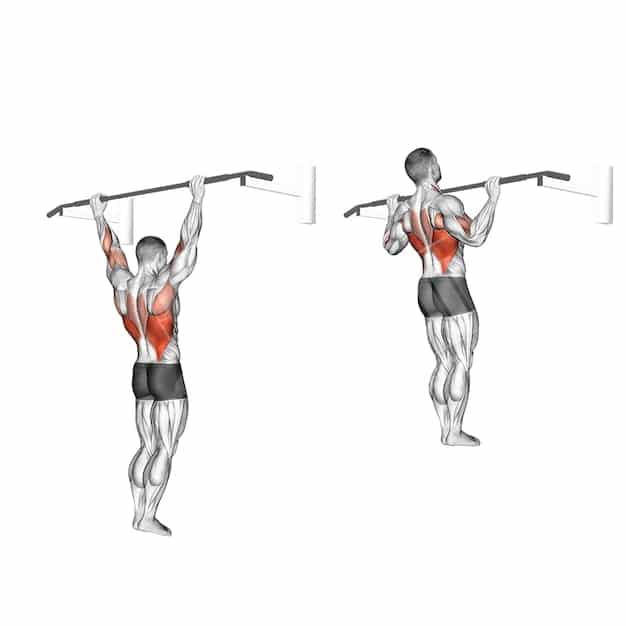Build a Bigger Back: The Ultimate 2025 Pull-Up Routine

Achieving a larger, stronger back is attainable through the 2025 pull-up progression routine, which integrates advanced training principles and diverse variations to enhance muscle growth and functional strength efficiently.
Are you ready to truly Build a Bigger Back: The Latest Pull-Up Progression Routine for 2025 is here to transform your physique and strength. This isn’t just another workout plan; it’s a meticulously crafted progression designed to push your limits and maximize your gains, ensuring a superior, more defined back.
The Science Behind Back Growth: Why Pull-Ups Reign Supreme
Building a robust, well-developed back is crucial not only for aesthetics but also for overall functional strength, posture, and injury prevention. The pull-up stands unparalleled as a compound exercise for targeting multiple muscle groups in the back, notably the latissimus dorsi, rhomboids, trapezius, and rear deltoids, while also engaging the biceps and forearms. Its inherent complexity requires synergistic muscle action, leading to comprehensive development that isolated exercises often fail to achieve.
Understanding the biomechanics of a pull-up reveals why it’s so effective. It’s a vertical pulling movement, mimicking natural human movements and engaging the primary muscles responsible for adduction, extension, and internal rotation of the shoulder joint, which are vital for a strong back. The adaptability of the pull-up, allowing for various grips and resistances, further enhances its utility in targeting different areas of the back and progressing strength over time. This makes it a cornerstone exercise in any serious back development program.
Muscular Anatomy and Activation
When performing a pull-up, several key muscle groups are activated dynamically. The latissimus dorsi, often referred to as “lats,” are the largest muscles of the back and are primarily responsible for the width and V-taper. Their activation pulls the humerus down and back towards the torso. The trapezius muscles, particularly the lower and mid traps, assist in scapular depression and retraction, contributing to upper back thickness and posture. The rhomboids, located between the shoulder blades, also play a vital role in retracting the scapulae, crucial for proper form and preventing shoulder impingement.
- Latissimus Dorsi: Primary movers for pulling the body up, responsible for back width.
- Trapezius (Lower/Mid): Support scapular movement and contribute to upper back thickness.
- Rhomboids: Essential for scapular retraction and stability.
- Biceps Brachii: Secondary movers, assisting in elbow flexion.
- Forearms/Grip: Crucial for maintaining hold and overall pulling power.
Beyond these primary movers, the pull-up also engages the core muscles for stability, the rotator cuff for shoulder health, and the deltoids for shoulder articulation. This full-body engagement ensures that improvements in pull-up strength translate to enhanced overall strength and body control, reinforcing its status as a foundational exercise for building a bigger, stronger back.
Deconstructing the 2025 Pull-Up Progression Routine: Core Principles
The 2025 pull-up progression routine is built upon several core principles designed to optimize muscle hypertrophy and strength gains. These principles go beyond simply adding more reps or sets; they involve strategic variations, intelligent overload, and meticulous attention to recovery. The goal is to consistently challenge the muscles in new ways, ensuring continuous adaptation and growth. This routine emphasizes quality over quantity, focusing on perfect form and controlled movements rather crop a larger impact on muscle fibers.
At its heart, this routine leverages the concept of progressive overload, but it refines it for specificity to pull-ups. This means not just increasing weight, but also manipulating tempo, grip, range of motion, and even rest periods to provide a diverse stimulus. The inclusion of advanced techniques—like cluster sets and eccentric training—ensures that plateaus are broken through, and new levels of strength and muscle mass are achieved. The routine is dynamic, allowing for adjustments based on individual progress and recovery, making it sustainable long-term.
Strategic Warm-Up and Activation
A proper warm-up is non-negotiable for maximizing performance and preventing injury. The 2025 routine begins with a dynamic warm-up focusing on shoulder mobility, scapular control, and thoracic spine extension. This prepares the muscles and joints for the demands of pull-ups, increasing blood flow and neural activation.
- Scapular Retractions: Focus on depressing and retracting shoulder blades without bending elbows.
- Band Pull-Aparts: External rotation and upper back activation.
- Arm Circles & Swings: Improve shoulder joint mobility and blood flow.
- Light Rows (Bodyweight or Banded): Activate the lats and rhomboids.
Following activation exercises, a few light sets of pull-up specific movements, such as dead hangs and negative pull-ups, can further prime the nervous system and muscle fibers for the main workout. This phased warm-up ensures that every muscle involved is ready to perform optimally, setting the stage for an effective training session.
Progressive Overload and Variation Tactics
The cornerstone of muscle growth is progressive overload, but in 2025, the application is more nuanced. Instead of simply adding weight, the routine incorporates different forms of resistance, such as weighted vests, chains, and resistance bands for assistance or additional challenge. Furthermore, manipulating rep ranges, sets, and rest intervals creates varied stimuli for muscle adaptation. For instance, sometimes the focus will be on low reps with heavy weight for pure strength, while other sessions might involve higher reps with lighter resistance for endurance and hypertrophy emphasis.
Grip variations are also integral to the 2025 progression. Wide grip pull-ups emphasize the lats for back width, while close grip chin-ups (supinated grip) heavily recruit the biceps and lower lats. Neutral grip pull-ups (palms facing each other) offer a balanced approach and are often easier on the shoulders. By regularly rotating these grips, you ensure comprehensive back development, hitting muscles from different angles and preventing adaptation plateaus. The routine also integrates advanced techniques like isometric holds at the top or bottom of the movement, which increase time under tension, a critical factor for hypertrophy.

The 2025 Pull-Up Progression Routine: Weekly Breakdown
This routine is structured across three distinct workout days per week, allowing for adequate recovery between sessions. Each day focuses on a different aspect of pull-up progression—strength, hypertrophy, and skill work—ensuring a well-rounded approach to back development. Consistency and adherence to the prescribed volume and intensity are paramount for optimal results. Remember that form always takes precedence over quantity of repetitions. If you find your form breaking down, either reduce the resistance or the number of repetitions. The routine is designed to be challenging but adaptable to various fitness levels, from intermediate to advanced. Beginners should focus on building foundational strength with assisted pull-ups before diving into weighted variations.
Day 1: Strength Focus (Weighted Pull-Ups & Negatives)
Day 1 is all about building raw strength, focusing on weighted pull-ups and eccentric (negative) training. Weighted pull-ups provide a direct means of progressive overload, forcing the muscles to work against greater resistance. Negative pull-ups, where you only perform the lowering phase of the movement slowly and controlled, are highly effective for building strength, particularly for those struggling with full pull-ups, as muscles are stronger eccentrically. This day aims to increase your maximum strength and improve your 1-rep max (1RM) for pull-ups.
- Weighted Pull-Ups (Pronated Grip): 3-5 sets of 3-6 repetitions. Choose a weight that allows you to maintain perfect form. Focus on a controlled pull-up and descent.
- Negative Pull-Ups: 3-4 sets of 4-8 repetitions. Jump to the top position and lower yourself slowly for 3-5 seconds.
- Weighted Chin-Ups (Supinated Grip): 3-4 sets of 5-8 repetitions. Focus on pulling through the lats and squeezing at the top.
- Planche Lean Progression: 3 sets of 10-20 seconds holds. This trains straight-arm strength and core stability, assisting with overall body tension during pull-ups.
Rest periods on strength day should be longer, typically 2-3 minutes between sets, to allow for full recovery of the ATP-PC system, which fuels explosive movements. The goal here is to lift heavy for fewer reps, maximizing neural adaptation and muscle fiber recruitment for strength gains.
Day 2: Hypertrophy Focus (Volume & Time Under Tension)
Day 2 shifts the focus to muscle hypertrophy (growth) through higher volume and increased time under tension. This day involves variations that allow for more repetitions and sustained muscle contraction. Utilizing drop sets, supersets, or cluster sets can be beneficial here to push muscle fatigue and enhance blood flow, contributing to the “pump” effect which is important for nutrient delivery and waste removal.
- Standard Pull-Ups (Pronated Grip): 4-5 sets of 8-12 repetitions. Focus on controlled movements, full range of motion.
- Neutral Grip Pull-Ups: 3-4 sets of 10-15 repetitions. Emphasize a strong squeeze at the top.
- Face Pulls (with resistance band or cable): 3-4 sets of 15-20 repetitions. Targets rear deltoids and upper back, improving shoulder health and posture.
- Inverted Rows (Bodyweight or Weighted): 3-4 sets of 12-18 repetitions. Great for complementary horizontal pulling strength, balancing back development.
Rest periods on hypertrophy day should be shorter, around 60-90 seconds, to maintain metabolic stress and promote cellular signaling for growth. The aim is to accumulate sufficient volume to stimulate muscle protein synthesis and promote anabolism, making sure muscles get adequate nutrients for recovery and growth.
Day 3: Skill Work & Active Recovery
Day 3 is dedicated to refining pull-up technique, working on weaknesses, and active recovery. This day is less about heavy lifting and more about honing your movement patterns and increasing training frequency without overtraining. This could involve practicing advanced pull-up variations like one-arm pull-up progressions, or focusing on mobility drills that specifically address any limitations in your pulling mechanics. Active recovery, such as light cardio or stretching, helps improve blood flow to tired muscles, accelerating the recovery process.
- Assisted One-Arm Pull-Up Negatives: 3-4 sets of 3-5 repetitions (per arm). Use a resistance band or hold onto a bench for assistance as you slowly lower yourself.
- Tuck Front Lever Holds / Progressions: 3 sets of 10-20 seconds holds. Develops core and straight-arm strength, crucial for advanced calisthenics moves.
- Mobility Drills (Thoracic Extension, Shoulder Dislocates with Band): 10-15 minutes. Improve range of motion and reduce injury risk.
- Light Cardio (Jogging, Cycling): 20-30 minutes. Aids in active recovery, promotes blood flow and reduces muscle soreness.
This session is crucial for long-term progress, as it addresses both specific skill development and overall physical well-being. It prevents burnout and ensures that your body is ready to tackle the strength and hypertrophy sessions with renewed vigor, paving the way for consistent gains and a continuously bigger back.
Optimizing Nutrition and Recovery for Maximum Back Growth
Training hard is only one piece of the puzzle; optimizing nutrition and recovery is equally, if not more, important for achieving significant back growth. Muscles don’t grow during the workout; they grow during the recovery period when they repair and adapt to the stress placed upon them. Neglecting these aspects will severely hinder your progress, leading to stagnation, fatigue, and potential injury. In 2025, the emphasis on integrated recovery protocols and precise nutritional timing is paramount for maximizing muscle protein synthesis and reducing inflammation, ensuring your body is always in an anabolic state, ready to repair and rebuild bigger and stronger.
Nutritional Pillars for Muscle Growth
Adequate caloric intake is fundamental for muscle growth. To build muscle, you need to be in a slight caloric surplus, meaning you consume more calories than you burn. This surplus provides the energy necessary for training and the raw materials for tissue repair and growth. Without sufficient calories, your body will struggle to build new muscle tissue, potentially breaking down existing muscle for energy instead. The quality of these calories also matters significantly, emphasizing whole, unprocessed foods over highly refined ones.
- Protein Intake: Aim for 1.6-2.2 grams of protein per kilogram of body weight daily. Protein is the building block of muscle, essential for repair and synthesis.
- Complex Carbohydrates: Provide energy for workouts and replenish glycogen stores. Include oats, brown rice, quinoa, and sweet potatoes.
- Healthy Fats: Crucial for hormone production and overall health. Sources include avocados, nuts, seeds, and fatty fish.
- Hydration: Drink plenty of water throughout the day. Dehydration can impair performance and recovery.
Timing your nutrient intake, particularly around your workouts, can further optimize recovery and growth. Consuming a blend of protein and carbohydrates before and after training helps provide immediate energy and kickstart the recovery process. This strategic approach to nutrition creates an optimal internal environment for muscle hypertrophy, acting as the fuel for your progress.

Advanced Recovery Modalities
Beyond traditional rest, 2025 introduces and refines several recovery modalities to accelerate muscle repair and reduce soreness. Sleep is undoubtedly the most critical recovery tool. During deep sleep cycles, growth hormone is released, and muscle repair processes are at their peak. Aim for 7-9 hours of quality sleep per night. Poor sleep can lead to hormonal imbalances, increased cortisol (a catabolic hormone), and decreased performance.
Active recovery, such as light cardio, foam rolling, and stretching, helps improve blood flow to the muscles, aiding in nutrient delivery and waste product removal. This can reduce delayed onset muscle soreness (DOMS) and improve flexibility. Cold therapy, like ice baths or cryotherapy, can help reduce inflammation and accelerate recovery, although its efficacy for muscle hypertrophy specifically is debated. What’s clear is that managing inflammation is key for chronic training adaptations. Prioritizing these recovery strategies will allow you to train harder, more frequently, and consistently, leading to superior long-term results for back development.
Finally, stress management should not be overlooked. Chronic stress elevates cortisol levels, which can have detrimental effects on muscle growth and overall health. Incorporating mindfulness, meditation, or spending time in nature can significantly aid in reducing stress and improving recovery. A holistic approach to wellness ensures that your body and mind are primed for optimal growth.
Common Pitfalls and How to Avoid Them in 2025
While the 2025 pull-up progression routine is highly effective, it’s not immune to common training pitfalls that can derail progress. Awareness of these issues and proactive strategies to avoid them are crucial for consistent gains. The journey to a bigger back is a marathon, not a sprint, and sustainable progress depends on avoiding injuries, sidestepping plateaus, and maintaining motivation. These pitfalls often stem from a lack of proper planning, impatience, or overlooking critical aspects of training and recovery, hindering adaptations and potentially leading to burnout or injury.
Over-Training and Under-Recovery
One of the most common mistakes is over-training, which often goes hand-in-hand with under-recovery. Pushing yourself too hard without adequate rest and nutrition can lead to diminishing returns, fatigue, increased risk of injury, and even a decrease in performance. Symptoms of over-training include persistent muscle soreness, decreased strength, irritability, disturbed sleep, and a lack of motivation. The 2025 routine is designed with built-in recovery days, but individual needs vary.
- Monitor Progress: Keep a training log to track strength and recovery.
- Listen to Your Body: If you feel unusually fatigued, take an extra rest day or reduce intensity.
- Prioritize Sleep: Ensure 7-9 hours of quality sleep every night.
- Nutrient Timing: Optimize pre and post-workout nutrition for rapid recovery.
Active recovery, like light movement or stretching on rest days, can also aid in mitigating soreness and improving circulation without adding excessive stress. Maintaining a balance between pushing your limits and allowing your body to recuperate is vital for long-term, sustainable back growth.
Poor Form and Ego Lifting
Compromising form for more repetitions or heavier weight is a classic pitfall that leads to ineffective training and greatly increases the risk of injury. Slinging your body around to get the chin over the bar, or using excessively heavy weights that prevent a full range of motion, will not only limit muscle activation but also put undue stress on joints and ligaments. The goal isn’t just to complete a pull-up but to perform it efficiently and safely, emphasizing the targeted musculature.
- Master the Basics: Ensure you can perform standard bodyweight pull-ups with perfect form before adding weight or advanced variations.
- Focus on Mind-Muscle Connection: Actively try to feel the muscles of your back working.
- Record Yourself: Use a phone to record your sets and review your form.
- Seek Feedback: Ask a knowledgeable coach or training partner to observe your technique.
Ego lifting—prioritizing heavy weights or high reps over correct technique—is counterproductive. It robs your muscles of the necessary stimulus for growth and sets you up for sidelining injuries. Always prioritize controlled, deliberate movements, even if it means reducing load or reps. Consistency with good form will always yield better results than sporadic lifting with poor technique.
Understanding and proactively addressing these common pitfalls will safeguard your progress and ensure you maximize the benefits of the 2025 pull-up progression routine. The emphasis must always be on smart training, listening to your body, and prioritizing long-term health over short-term gratification.
| Key Aspect | Brief Description |
|---|---|
| 💪 Strength Focus | Weighted pull-ups and negatives to boost raw pulling power. |
| 📈 Hypertrophy Focus | Volume and time under tension with varied grips for muscle growth. |
| 🧘 Recovery & Nutrition | Crucial for muscle repair and optimal performance. |
| 🚫 Avoid Pitfalls | Prevent overtraining and maintain precise form for consistency. |
Frequently Asked Questions
▼
For optimal back growth, training pull-ups 2-3 times per week is generally recommended. This frequency allows sufficient muscle stimulation while providing adequate recovery time between sessions. More frequent training can lead to overtraining, especially for advanced routines, potentially hindering progress and increasing injury risk. Adjust frequency based on your recovery capacity.
▼
Absolutely. Even if you can’t perform many pull-ups, focusing on progressive overload using assisted variations (resistance bands, negative pull-ups, or spotter assistance) can effectively stimulate muscle growth. The key is to challenge your muscles gradually, ensuring you’re adding resistance or reducing assistance over time. Consistency with these modified exercises will lead to increased strength and hypertrophy.
▼
Grip strength is extremely important for pull-ups as it is often a limiting factor. A strong grip allows you to hold onto the bar longer and focus on recruiting your back muscles effectively. Incorporating specific grip exercises like dead hangs, farmer’s walks, and plate pinches can significantly improve your pull-up performance and, consequently, your back development by allowing you to handle more resistance.
▼
Pull-ups (pronated grip or palms facing away) primarily target the latissimus dorsi, emphasizing back width. Chin-ups (supinated grip or palms facing towards you) also engage the lats but put more emphasis on the biceps and the lower portion of the lats. Incorporating both variations in your routine provides a comprehensive stimulus for overall back thickness and width, leading to a more defined physique.
▼
While whole foods should be your primary focus, certain supplements can complement your pull-up progression. Creatine can enhance strength and power output, allowing for more intense training sessions. Protein powder helps meet daily protein requirements for muscle repair and growth. BCAAs (Branched-Chain Amino Acids) may aid in reducing muscle soreness and fatigue, supporting recovery. Always consult a healthcare professional before starting any new supplement regimen.
Conclusion
The journey to build a bigger, stronger back is a multifaceted endeavor that extends beyond mere sets and repetitions. The 2025 pull-up progression routine integrates cutting-edge training principles, diverse variations, and a profound emphasis on recovery and nutrition. By adhering to this meticulously designed program, focusing on progressive overload, perfecting form, and prioritizing your body’s restorative needs, you will unlock unprecedented levels of strength and muscularity. This routine provides a comprehensive roadmap, enabling you to transcend previous limitations and sculpt a truly impressive back that epitomizes functional power and aesthetic appeal. Embrace the challenge, stay consistent, and witness the transformative results for yourself.





